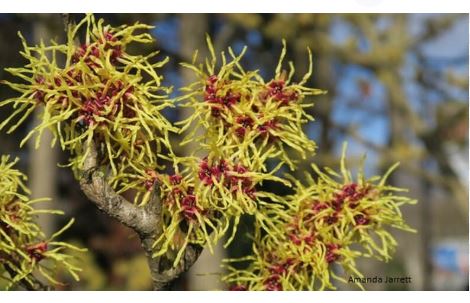
Chinese Witch Hazel (Hamamelis mollis) is part of the Hamamelidaceae family within the Hamamelis genus. It’s known for its fragrant, showy flowers, distinguishing it among witch hazels.
This species is native to central and eastern China, specifically found in provinces like Hubei, Hunan, and Sichuan. It naturally grows in the understory of deciduous forests, often near streams or on slopes where soil moisture is higher.
Chinese Witch Hazel has been used in traditional Chinese medicine for centuries, similar to its North American counterparts, for treatments ranging from inflammation to skin conditions. Its introduction to the West in the 19th century was primarily for ornamental purposes, leading to its popularity in gardens due to its winter blooming and fragrance.
Chinese Witch Hazel is a deciduous shrub or small tree, growing to about 10 to 15 feet tall with a similar spread. It’s renowned for its strongly scented, bright yellow flowers that bloom in late winter to early spring, offering a delightful fragrance when few other plants are flowering. The leaves are large, rounded, and turn a rich yellow in the fall. Like other witch hazels, it produces woody capsules that explosively release seeds when mature.
It’s hardy in USDA Zones 5 through 8, which means it can tolerate a range of temperatures but prefers climates with cold winters and mild summers to mimic its natural habitat.
With proper care, Chinese Witch Hazel can live for many decades, often exceeding 50 years. Its slow growth rate and hardy nature contribute to its longevity.
Landscape Uses
Chinese Witch Hazel has several landscape applications:
- Ornamental Value: Its vibrant, fragrant flowers make it a star in winter gardens, providing color and scent when most landscapes are barren.
- Winter Interest: The combination of its bloom time and fragrance makes it an invaluable plant for sensory gardens or any garden needing winter interest.
- Screening: Can be used as an informal hedge or screen, especially where the fragrance and color can be appreciated up close.
- Naturalizing: Suitable for woodland gardens where its natural growth habit can blend seamlessly with native or other Asian plants.
- Pollinator Attraction: Although blooming in winter, it still attracts some early insects, contributing to biodiversity.
- Urban Landscaping: Its adaptability to various soil conditions and tolerance to urban pollution make it a good choice for city gardens.
- Sensory Gardens: The plant’s strong fragrance is perfect for areas designed to engage the senses.
- Specimen Plant: Given its architectural form and spectacular blooms, it works well as a focal point in garden designs.
Chinese Witch Hazel (Hamamelis mollis): Cultivation
Choosing the Right Location
Vernal Witch Hazel prefers full sun to partial shade, particularly excelling in locations that provide morning sun and afternoon shade. This helps protect it from the harshest summer sun while ensuring enough light for blooming.
Soil Requirements
This plant thrives in well-drained, moist soils but can adapt to various soil types, including sandy or clay, as long as water doesn’t stagnate around the roots. Slightly acidic to neutral pH is ideal, but it’s quite tolerant. Amending heavy clay with organic matter can improve drainage.
Planting
Plant in spring or fall for best establishment. Dig a hole twice as wide but no deeper than the root ball. Place the plant, ensuring the root collar is level with the soil surface, backfill, and water well to settle the soil around the roots.
Watering
Water regularly during the first couple of years to establish the root system. Once established, Vernal Witch Hazel is reasonably drought-resistant, but deep watering during extended dry spells will promote health and flowering. Avoid waterlogging to prevent root rot.
Mulching
Mulch around the base with a 2-3 inch layer to conserve soil moisture, regulate temperature, and suppress weeds. Keep mulch away from touching the trunk to avoid potential rot.
Pruning
Pruning is generally not necessary except to remove dead or diseased wood or to shape the plant. If needed, prune right after flowering in late winter or early spring, before new growth begins. Since it blooms on old wood, avoid heavy pruning to ensure flowering.
Fertilization
Fertilization is rarely required for Vernal Witch Hazel due to its adaptability to different soil conditions. If the growth seems stunted or the leaves lack color, a light application of a balanced, slow-release fertilizer in early spring can be beneficial.
Pest and Disease Control
This species is relatively pest-free but can occasionally be affected by aphids or scale. Fungal diseases like powdery mildew might occur in overly wet conditions; promote good air circulation to minimize this risk. Insecticidal soap can be used for minor pest issues.
Propagation
Propagation can be done via seeds, which require cold stratification for germination, or through softwood cuttings taken in late spring to early summer. Seedlings will take longer to mature and flower than those from cuttings.
Managing Growth
Vernal Witch Hazel can spread through suckers, though less aggressively than some relatives. Regularly check for and remove unwanted suckers if you need to control its spread or maintain a specific shape.
Winter Care
In its hardiness zones, it’s quite cold-resistant, requiring no special winter protection. However, young plants or those in very exposed locations might benefit from a layer of mulch for root insulation.
Landscape Integration
Place Vernal Witch Hazel where its early blooms can be enjoyed, like near pathways or windows. Its winter flowering makes it an excellent choice for extending garden interest into the colder months. Consider companions that will bloom later to maintain garden color throughout the year.